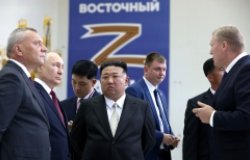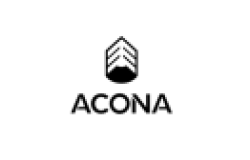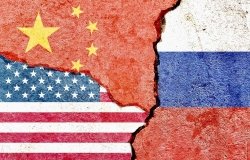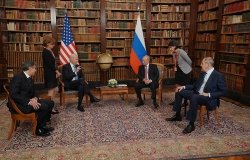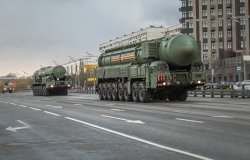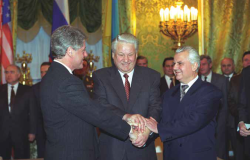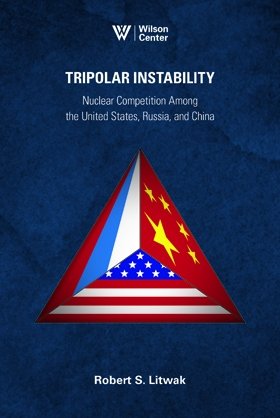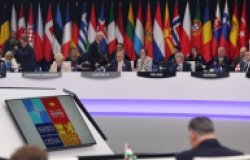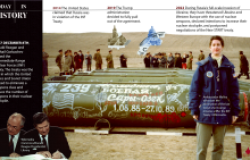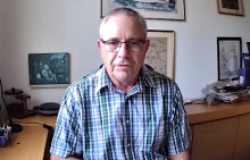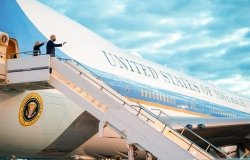The Pervez Case, Pakistani Nuclear Procurement, and Reagan Administration Nonproliferation Policy, 1987
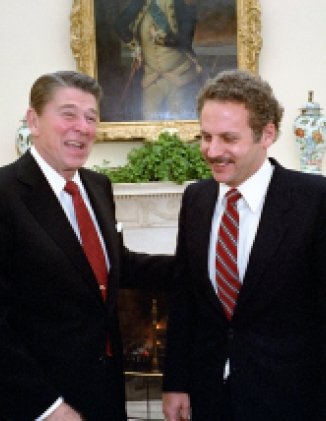

Pakistan’s Illegal Nuclear Procurement Exposed in 1987
Arrest of Arshed Pervez Sparked Reagan Administration Debate over Sanctions
Newly Declassified Documents Show Illegal Network Had Islamabad’s “Approval, Protection, and Funding”
Reagan White House Chose Afghan War over Nonproliferation Enforcement
The arrest of a Pakistani national, Arshed Pervez in July 1987 on charges of illegal nuclear procurement roiled U.S.-Pakistan relations and sharpened divisions within the Reagan administration, according to recently declassified documents published today by the National Security Archive and the Nuclear Proliferation International History Project. Arms Control and Disarmament Agency (ACDA) director Kenneth Adelman wanted to crack down on the Pakistani nuclear program by cutting military and economic aid; Adelman argued that failure to do so “would be seen as ‘business as usual,’” taking the pressure off Pakistan “at the very time we should be trying to increase pressure on them to stop … illegal procurement activities in the US.” By contrast, the State Department took a contrary view because U.S. aid to Pakistan supported the mujahidin in Afghanistan: “We are particularly concerned about weakening the President’s hand in discussions with the Soviets on Afghanistan, which [are] at a critical stage.”
Pervez, who had tried to bribe a Customs official to get an export license, sought to purchase high strength maraging steel, uniquely suited for gas centrifuge enrichment technology, and quantities of beryllium for his country’s covert nuclear program. This arrest and then an indictment in California on another case[i] made headlines in the United States. Adelman wanted President Reagan to invoke the Solarz amendment (after then-Rep. Stephen Solarz, D-NY), which required an aid cut-off in the event that governments receiving U.S. aid or their agents illegally tried to procure material that could be used for a nuclear weapons program. Reagan, however, refused to invoke the Solarz amendment. Although Pervez would be found guilty, the White House kept U.S. aid flowing to Islamabad for reasons of “national security.”

For the Reagan administration, aiding the anti-Soviet war in Afghanistan trumped nonproliferation policy interests. The high priority given to a close U.S.-Pakistan relationship may have encouraged, as some journalists have alleged, State Department officials to warn the Pakistanis of the imminent arrest of their agents.[ii] Indeed, a key figure in the A. Q. Khan nuclear procurement network, Inam Ul-Haq, who was working closely with Pervez, evaded arrest by slipping out of the United States at the last minute. A few weeks later, Under Secretary of State for Political Affairs Michael Armacost explained to Pakistani dictator General Muhammad Zia-ul-Haq that State had unsuccessfully tried to get information about the Customs Bureau’s investigation of Perez, but “we did alert the GOP [Government of Pakistan] through letters, Ambassador Hinton, and our talks with the Foreign Minister that there was an issue here that needed to be addressed urgently.” “I understand the idea of warning, Zia replied.” Future declassifications may elucidate exactly what these urgent alerts amounted to.
The Pervez case demonstrates how U.S. government agencies, including the Customs Bureau and ACDA, sought to monitor and disrupt Pakistan's nuclear procurement activities. For its part, the Reagan White House used loopholes in U.S. nonproliferation laws to avoid the enforcement of sanctions on Pakistan. The documents released in today's publication illustrate these and related developments. They include:
- Records compiled by U.S. government lawyers for prosecuting Pervez, including correspondence between Pervez and the Khan front company, Multinational, Inc., Pervez’s correspondence with Carpenter Technology Corporation, the supplier of maraging steel, and Pervez’s personal notes, which include references to “atom” and “military” which his lawyers could not explain.
- A memorandum by Kenneth Adelman shortly after Pervez’s arrest: “If we now ‘lawyer our way around’ the Solarz amendment”, and seek to avoid its enforcement, “Zia will conclude once again that he need do nothing about his bomb program.”
- An ACDA memo on the applicability of the Solarz amendment which concluded that “there is no plausible end-use for 25 tons of grade 350 maraging steel other than in the manufacture of centrifuges” for producing highly-enriched uranium and “for which Pakistan has no use except in nuclear explosives.”
- A record of meetings on 5 August 1987 between general Zia and Under Secretary Armacost. Seeing a “conspiracy” to harm U.S.-Pakistan relations, Armacost observed that Washington could not simply “wink” at Pakistani procurement operations. He later said that U.S. government “information” indicated that “enrichment levels above 90[percent] have been achieved at Kahuta,” the site of a secret gas centrifuge facility. This meant that Pakistan was producing weapons-grade material in violation of an earlier commitment to a five percent ceiling.
- A State Department Intelligence and Research report that characterized Pervez as “a convenient tool” for Pakistani nuclear procurement agents “to use in obtaining sensitive goods in the US.” They supplied Pervez with nuclear “shopping lists” that showed that his “activities were part of a larger government-supported plan.”
Besides the Solarz amendment, other acts of Congress were at issue in the debates sparked by the Pervez affair. One was the Pressler amendment (1985), after Senator Larry Pressler (R-SD), which required annual certification that Pakistan did not possess a nuclear explosive device. The other was the Symington amendment (1976); named after Sen. Stuart Symington (D-MO); it prohibited aid to non-NPT countries that initiated uranium enrichment programs for producing nuclear weapons. In 1979, under the Symington amendment, the Carter administration suspended aid to Pakistan after it discovered the Kahuta enrichment plan. When the Reagan administration came to power in 1981 it worked with Congress to give Pakistan a five-year waiver of the amendment because of its role in funneling U.S. aid to the Mujahadin in Afghanistan. Nevertheless, Congress imposed conditions – for example, aid would stop if Pakistan tested a nuclear weapon. With the waiver expiring in Fall 1987, the Reagan White House successfully finessed the Pervez affair so that it could justify continued economic and military aid to Pakistan.[iii]
What had inspired the 1979 application of the Symington amendment was the discovery of Pakistan’s purchases of dual-use technology for its uranium enrichment program. A. Q. Khan was one of the founders of the Pakistani nuclear procurement system, but with other countries seeking specialized technology for their nuclear programs illegal networks have flourished. A recent report by the Institute for Science and International Security reminds us that illegal procurement networks for nuclear technology continue to pose a challenge to law enforcement and nonproliferation policy. The acquisition of material for gas centrifuges is central to this activity and maraging steel remains a commonly sought item by the procurement networks. This puts the Pervez incident in perspective as an event in the historical continuum of illegal procurement organizations for nuclear programs. What make this case distinctive is that Pervez was caught and his activities were documented.
The documents in today’s posting only give part of the story, mainly the ACDA perspective and the nuts and bolts of Pervez’s procurement activities as presented in the trial documents. The State Department is coordinating the review of other documents on the Pervez case with other agencies and offices (probably including CIA), and some denied items are under appeal. The Archive has also requested declassification of a November 1987 memorandum by Secretary of State George Shultz to President Reagan arguing against penalizing aid to Pakistan. Assuming that some of these documents get declassified, more light will be shed on the way that the Reagan administration handled the Pervez case.
Note: Except for document 9 and the Reagan public statements, all items below are from recent Department of State mandatory declassification review releases.
Documents 1A-B: Tracking the Khan Network
A: Department of State telegram 287763 to Embassy Bonn, “Export of Uranium Enrichment equipment to Pakistan,” 19 September 1985, secret.
B: Embassy Bonn telegram 35237 to Department of State, “Export of Uranium Enrichment to Pakistan,” 22 November 1985, secret
As these telegrams demonstrate, by Fall 1986, if not earlier, the U.S. government believed that a Pakistani firm, Multinational Inc., was a “procurement agent” for A.Q. Khan’s secret network. In this case, Pakistani agents operating in West Germany were trying to secure aluminum tubes that could be used for the Khan Laboratory’s gas centrifuge program. The State Department sent the U.S. Embassy talking points that could be used for a “non-paper” for German officials. According to the Foreign Office’s response, the equipment had not been delivered and German firms had been informed that an export license needed to be granted. More needs to be learned about the follow-up in West Germany, but Multinational Inc. would surface in the Pervez case.
Document 2: Embassy Islamabad cable 11791 to Department of State, “Nuclear: Solarz Conversation with GOP,” 29 May 1986
The year after Congress passed the Solarz amendment in August 1985, Rep. Stephen Solarz (D-CA) traveled to Pakistan, a country that would become a major test case for the amendment which cut off U.S. foreign aid to recipients. Solarz confronted General Zia and other top officials with his perception, based on U.S. intelligence, that Pakistan’s Kahuta plant was enriching weapons-grade enriched uranium. The Pakistanis strenuously denied the charge, arguing that if their “word” could not be accepted there would be no “basis for the relationship.” Solarz argued for independent verification of that claim but the Pakistanis argued that would be an unacceptable intrusion on their sovereignty. The possibility of a regional nuclear solution was discussed but the Pakistanis argued that India had been unresponsive to their proposals.
During a discussion with Pakistan Atomic Energy Commission (PAEC) chairman Munir Khan which included Australian and British diplomats, the question arose what would happen if Washington terminated aid to Pakistan in 1987. The Australians and British “posited” that Pakistan would “seek an accommodation on Afghanistan,” presumably through a deal with Moscow.
Document 3: State Department telegram 215122 to Embassy Islamabad, “Maraging Steel Case: Press Guidance,” 14 July 1987, unclassified
The Pervez arrest immediately raised questions in the media but the State Department would say little other than: let the legal system do its work, no speculation about Pervez’s intentions, and the admission that the Department had expressed concern to Pakistan about the “overall nature and direction of [its] nuclear program.” No decision had been made whether to invoke the Solarz amendment and suspend aid.
Document 4: Arms Control and Disarmament Agency, Memorandum from Kenneth Adelman to Under Secretary of State for Political Affairs, “Your Meeting with Ambassador Merker,” 14 July 1987, secret
When ACDA director Kenneth Adelman saw the State Department talking points for a conversation with Pakistani ambassador Jamsheed Marker about the Pervez case he was irritated by the “business-as-usual” tone. If the comments did not express “outraged indignation,” Pakistan “will continue its bomb program and continue to lie to us.” Apparently, the language was strengthened in the final version (see document 7).
Document 5: Arms Control and Disarmament Agency, Memorandum from Norman Wulf, Director to the Director, “Solarz Amendment Applicability to the Pakistani Procurement Case.” 16 July 1987, secret
Immediately arms control experts began to review available information about the Pervez case and drafted preliminary answers to whether the Solarz amendment was applicable. ACDA official Norman Wulf saw a good case, with the information supporting positive answers to basic questions: would the maraging steel to be used for nuclear weapons manufacture, was the Pakistani national working on behalf of his government, would the steel “contribute significantly” to a capability to manufacture a nuclear explosive, and was there an “attempted illegal export”?
Document 6: Department of State, Memorandum from Ted Borek to Mr. Peck [et al.], “Letter to Justice on Pakistan Export Case,” 15 July 1987, unclassified
This draft of a State Department letter to the Justice Department, that was presumably sent soon thereafter, supported prosecution of Pervez to the “fullest extent of the law.” The cover memorandum mentioned an earlier smuggling case involving Nazir Ahmed Vaid which raised “allegations …that the Department had intervened to prevent a more vigorous prosecution.”[iv] The State Department lawyers denied the allegations, but in handwritten comments ACDA official Norman Wulf (an attorney by training) saw a different problem: not the prosecutor’s handling of the case, but the “lenient sentence.” To prevent a recurrence, Wulf suggested that the letter include the concept of a “stiff sentence” if prosecution led to conviction, although it was necessary to avoid “prejudicing the rights of the accused.”
Document 7: Department of State, Memorandum from Ted Borek to Mr. Peck [et al.], “Solarz Amendment: Legal Memorandum for Mr. Armacost,” 20 July 1987, limited official use
The Pervez case immediately raised questions among State Department lawyers about the relevance of the Solarz amendment. A final answer depended on more evidence; the lawyers wanted to see the many documents that Canadian authorities had impounded as well as the tape recordings of Pervez’s conversations with U.S. undercover agents. Nevertheless, enough information was available for a general discussion of the “elements … which must be satisfied to trigger the Amendment.” One point of controversy was when a president should act, for example, whether the president had the “discretion to withhold action while criminal proceedings are in progress.” Not only could the results of the proceedings clarify the case, presidential action “could prejudice the criminal proceedings.” The State Department and the Justice Department favored maximum presidential discretion, but Congressman Solarz argued that this was not what Congress had in mind: “it intended the President to act if he believed on the basis of a preponderance of the evidence that the illegal conduct occurred.”
Document 8: U.S. Arms Control and Disarmament Agency, Memorandum from Kenneth Adelman for the Undersecretary of State for Political Affairs, “The Pakistani Procurement Cases,” 23 July 1987, secret
What State Department lawyers had in mind aggravated ACDA director Adelman who believed that they might “lawyer their way around” the Solarz amendment. With Pakistan already violating the “red line” on uranium enrichment, Adelman believed that without a display of resolve “presidential credibility” would be further damaged; that required cutting off aid under the Solarz amendment. Reagan should offer to waive the amendment only if the Pakistanis stopped procurement activities and undertook a verifiable halt to enrichment above five percent. As it was, aid to Pakistan would automatically stop on 30 September when the waiver to the Symington amendment expired and it would be difficult to persuade Congress to approve the restoration of aid unless Reagan “demonstrates that he takes the Solarz amendment seriously.”
Document 9: National Security Council, Memorandum from Shirin Tahir-Kheli to Robert Oakley,” Dealing with Pakistan’s Nuclear Program: A U.S. Strategy,” 23 July 1987, secret Source: Ronald Reagan Presidential Library
This memorandum by a senior NSC staffer took the Pervez case seriously as a threat to aid to Pakistan that Islamabad needed to avert by making “reliable assurances on enrichment and on illegal procurement activities.” Instead of focusing on the U.S. dilemma of balancing nuclear proliferation and Cold War concerns, Washington should “shift the onus of maintaining the relationship onto” the Government of Pakistan. Something “substantial had to be done” because the Pervez case was an embarrassment to the President and involved a violation of U.S. law. Among the options that Tahir-Kheli believed were worth discussing were “verification of limits on enrichment,” “identification of parties responsible for illegal activities” and “action against” them, a decision, with a “written commitment,” to adhere to the five percent enrichment level, and “institutional measures” to curb illegal procurement activities.
Document 10: Arms Control and Disarmament Agency, Briefing Memorandum from Anthony Salvia to the Director, “HFAC Asia Subcommittee Hearing on Pakistan,”24 July 1987, unclassified, with Bonker-Fascell letter to Reagan attached
A hearing by the House subcommittee on International Economic Policy and Trade on 22 July 1987 made it clear why administration officials worried about the implications of the Pervez case. With Congressman Solarz arguing that the arrest involved “a flagrant and provocative challenge to U.S. nonproliferation objectives.” A number of subcommittee members called for a temporary suspension of aid to Pakistan; a letter to President Reagan from subcommittee chairman Don Bonior (D-WA) and Foreign Affairs Committee chairman Dante Fascell (D-Fl) recommended aid suspension along with a “review with Pakistani leaders [of] the future direction of our relations.” Others on the subcommittee, such as Rep. James Leach (D-IA) “urged caution” and suggested “intermediate sanctions,” for example, a partial aid cut-off. He argued that the “problem with the Solarz amendment” was that it “puts the Administration so much on the spot that a national security waiver is virtually inevitable.”
Document 11: U.S. District Court, “Indictment: U.S. of America Vs. Arshad Pervez and Inam Ul-Haq,” 28 July 1987.
The indictment against Pervez and Ul-Haq included charges of conspiracy, bribery, racketeering, export violations, and false statements. The key element in the case was the illegal effort to acquire 1) 350 maraging steel that would be “used in a uranium enrichment plant to manufacture nuclear weapons,” and 2) beryllium, used specifically for the neutron initiator in a nuclear weapon, the export of which was controlled in the government’s Commodity Control List.
Document 12: Department of State, “Classified Congressional Briefing on Pakistani Clandestine Nuclear-Related Procurement, “circa 26 July 1987, secret.
These are the Department’s talking points, intended for use with Congress. While ACDA officials were fairly certain that a violation of the Solarz amendment had occurred, the State Department did not want to assume anything until it had reviewed the evidence. What comes across very clearly is a strong aversion to “hasty reaction to this case” because of the situation in Afghanistan. “We are particularly concerned about weakening the President’s hand in discussions with the Soviets on Afghanistan, which is at a critical stage.” Moscow’s “incentives to reach a settlement” could be reduced if “US resolve or ability to work with Pakistan” was in doubt.
Document 13: Department of State, Draft telegram to Embassy Athens [et al.], “Pakistani Circumvention of Nuclear Export Controls,” 28 July 1987, Secret
Whatever the State Department told Congress, nuclear experts in the State Department were more certain that the maraging steel was “probably intended” for the Pakistani gas centrifuge program. This telegram included information that U.S. embassies were to share with foreign governments to help them tighten up their export controls. While maraging steel tubes were specifically subject to international export controls, the raw maraging steel bars that Pervez sought “requires a license if the exporter has reason to know that the material will be used in uranium enrichment.”
Documents 14A-D: Armacost Meeting with General Zia:
A. Embassy Islamabad telegram 16294 to Department of State, “First Day in Islamabad—August 2,” 3 August 1987, secret
B: Embassy Islamabad telegram 16556 to Department of State, “Under Secretary Armcost Meeting with Zia,” 5 August 1987, secret
C: B. Department of State telegram 244270 to the Embassy in Islamabad, “Under Secretary Armacost Meeting with Zia,” 7 August 1987, secret
D: Embassy Islamabad telegram 16052 to Department of State, “Pervez Nuclear Arrest Case—July 23 Statement by MFA Spokesman Gives Greater Emphasis to Conspiracy,” 30 July 1987, confidential
Only a few weeks after Pervez’s arrest, Under Secretary of State Armacost traveled to Pakistan for wide-ranging discussions with General Zia, but with a special focus on nuclear procurement and the uranium enrichment program. As Armacost reported to Secretary Shultz, “I emphasized the need for immediate practical steps to demonstrate to an aroused Congress and a skeptical administration that no further illegal procurement activities would take place and that we had verifiable assurances there would be no further enrichment of weapons-grade uranium.” The talks had their tense moments, for example, when Zia argued that Washington was trying to “get one Pakistani in order to hang the entire government.” Using language that was becoming routine at the Foreign Ministry, Zia said he saw a “conspiracy to destroy” U.S.-Pakistan relations and denied that Pervez had any connections with Pakistani government agencies. He argued that the maraging steel could be “used for 20 or more different things.”
Declaring that the administration had an “open mind” about the Pervez case, Armacost nevertheless observed that “the only apparent use for this grade of maraging steel [was] for a gas centrifuge.” What Armacost wanted in particular were Pakistani actions that he could tell Congress about, such as government “instructions” that showed it was trying to stop illegal procurement in the United States and that it would extradite Brigadier Inam. Zia declared that Pakistan would cooperate to “prevent illegal procurement;” he asked for a list of illegal items and said that steps would be taken to “tighten up” procurement operations.
Armacost raised the matter of Pakistan’s commitment to follow a five percent ceiling for uranium enrichment, noting that U.S. government “information” indicated that “enrichment levels above 90 have been achieved at Kahuta” in violation of the 5 percent ceiling that Zia had accepted in discussions with President Reagan. Zia laughed off the charge but then declared that the U.S. government “will have to accept my word.” Nevertheless, he agreed to a meeting between Chairman of the Pakistan Atomic Energy Commission Munir Khan and Ambassador-at-Large Richard T. Kennedy (whose portfolio was nonproliferation policy) to confirm the “five percent level.”
When the embassy in Islamabad sent to the State Department a record of the conversation, Armacost had not reviewed the first 45 paragraphs; subsequently, his assistant Andrew Steinfeld sent a corrected copy that had interesting and sometimes important differences from the original (for example, compare the versions of paragraphs 14 and 34).
Document 15: Arms Control And Disarmament Agency, Memorandum from Norman Wulf to the Director, “Recent Activities Related to the Pakistani Procurement Case,” 10 August 1987, secret
Following up the Armacost-Zia talks, ACDA official Norman Wulf reviewed plans for a “dialogue” with Pakistan to prevent illegal procurement in the United States and verification of the five percent enrichment commitment. Adelman probably wrote the marginal comment on the document, “Better than nothing.”
Document 16: Arms Control and Disarmament Agency, Memorandum from Norman Wulf to the Director, “Weekly Activities Report,” 13 August 1987, secret
Wulf reported to Adelman that the information telegram on the Pervez and other smuggling cases [see Document 13] had gone out to the embassies (except for the Soviet bloc) and had received a favorable response from nuclear-supplier states. ACDA had proposed a “range of overt, technical means” to verify the five percent commitment and it was under further review. Adelman wanted ACDA to “hammer home on the 5% firewall” and not let procurement “be sole topic.”
Document 17: Embassy Islamabad telegram 17754 to the Secretary of State, “Pervez Case-GOP Regulation on Procurement Activities,” 23 August 1987, Secret
During the Armacost-Zia talks, the Pakistanis had told U.S. officials that they would confidentially share any new procurement regulations with them. The embassy reported that a “roadblock” had emerged and that Foreign Minister Yaqub Khan was looking into why the regulations had not been made available. The Pakistanis made available some documentation later [see document 26] but the specifics have not been disclosed.
Document 18: Consulate Lahore telegram 0524 telegram to Embassy Islamabad, Information Department of State, “Pervez Nuclear Arrest Case – Possible Location of Brig. Inam Ul Haq,” 2 September 1987, Confidential, excised copy
A confidential source told consular officials that the Pakistani government had detained Inam Ul Haq and was “being rotated between various locations” in Pakistan-controlled Kashmir. The source did not know this first-hand, but had another source “that he is convinced is correct.”
Document 19A-C: Getting the Pervez Documents from Canada
A: Department of State telegram 270161 to Embassy Ottawa, “Access to Canadian Documents in Pervez Case,” 29 August 1987, Secret
B: Ted Borek to Mr. Peck et al, “Draft Note to Canadians on Pervez Documents,” 4 September 1987, with Ottawa embassy telegram, 3 September 1987 attached, secret
C: State Department telegram 278631 to U.S. Embassy Ottawa, “Access to Canadian Documents in Pervez Case,” 5 September 1987, secret
The Canadian government cooperated with the U.S. Justice Department in the Pervez case by seizing documents at his and making them available to federal prosecutors. The State Department wanted permission to review the documents “on the premises of the U.S. law enforcement authorities” so that it could use them to prepare recommendations to President Reagan “concerning a decision regarding the applicability of the Solarz amendment.” These documents concern messages to the Canadian government on the request for access; how and when Ottawa responded is not clear, although presumably it gave permission.
Document 20: Arms Control and Disarmament Agency, Memorandum from Kenneth Adelman to Under Secretary of State for Political Affairs, “A Strategy on Pakistan,” 4 November 1987, secret
Continuing to take a tough line on Pakistan, Adelman advised Armacost to “increase pressure on Pakistan to try to get them to stop enrichment above five percent and to stop illegal procurement activities in the United States.” To do this he suggested holding off until January any certification that Pakistan does not “possess a nuclear explosive device” (as required by the Symington Amendment). Moreover, he recommended invoking the Solarz amendment but not making a decision on “waiving its restrictions” also until January. On Solarz “the facts certainly support such a finding” and leaving the decisions in suspense would act as pressure on Islamabad.
Document 21 A-D: U.S. v. Arshad Pervez, Criminal Number 87-00283 “Exhibit List,” circa November 1987
A: Exhibit List
B: Exhibits 24 through 38-37
C. Exhibits 38-38 through 38-85
D: Exhibits 38-86 through 52
Most of the copies of the exhibits provided by the State Department lacked the original exhibit numbers. Nevertheless, to the extent possible the documents reproduced here follow the order of the exhibit list. Some exhibits are unavoidably missing, such as a videotape and $1,000 in 100 dollar bills, but what is available provides a good sense of Pervez’s efforts on behalf of the A. Q. Khan front, Multinational Inc., to purchase the maraging steel. Included is correspondence from Multinational Chief Executive Inam-Ul-Haq to A.P. Enterprises, run by Pervez, and from Carpenter Technology Corporation to A.P. Enterprises with price quotes for the steel.
The exhibits included Pervez’s notebooks with such incriminating language as “atom,” “military,” and “my expert is procurement manager for nuclear plant.” [See Document B at PDF pages 24 and 26]. A letter from Ul-Haq to Pervez [See Document B at PDF page 45] from early 1987 demonstrated that this was more than a business venture: “personal interests must not be allowed to overtake national interests.” Pervez had taken some financial losses and Ul-Haq observed that “in this bargain I have suffered a loss of nearly 15000 $.” The losses, however, could be “made up” by getting an “order for other items.”
Document 22: Arms Control and Disarmament Agency, Memorandum from Kenneth Adelman for the President, “Certification on Pakistan,” 21 November 1987, Secret
By the time that Adelman signed this memorandum to President Reagan, Secretary Shultz had recommended that Washington “now certify” that Pakistan “does not possess a nuclear device” (as required by the Pressler amendment). Noting that aid deliveries would not restart until December, Adelman asked Reagan to delay certification as a way to keep “pressure” on the Pakistanis to stop enriching uranium and crack down on illegal procurement. He also called for invoking the Solarz amendment to avoid giving a “business as usual perception.”
Documents 23A-C: Pervez Trial and Verdict
A: Department of State, memorandum from Jonathan Schwartz to Ms. Verville [et al.], “Pervez Trial Status,” 14 December 1987, unclassified
B: Department of State telegram to U.S. Embassy Islamabad, “Pervez Case Verdict,” 17 December 1987, unclassified
C: Department of State, Memorandum from Jonathan Schwartz to Mr. Keczko [et al.], 23 December 1987, unclassified, excised copy
After hearing tape-recorded conversations and seeing Pervez’s diary entries and the Pervez-Carpenter correspondence, on 17 December 1987, the jury found him guilty on 5 out of 8 counts, including conspiracy, attempted export of beryllium without the required license, and submitting false end-use statements about the maraging steel. Inam Ul-Haq was also found guilty of conspiracy and false statements. The three charges relating to bribery did not hold up, possibly because the defense had argued that the government had entrapped Pervez. In any event, according to a State Department report, the jurors found Pervez’s testimony “confused and not credible” and “accepted the theory that [he] was part of a plot to send nuclear materials to Kahuta for an enrichment program aimed at producing nuclear bombs.”
Document 24: President Reagan to Speaker of the House, 17 December 1987, enclosing presidential determination
Source: Digital National Security Archive
Apparently following Shultz’s advice, Reagan informed Congress that he had “concluded that Pakistan does not possess a nuclear explosive device.” Not only would that allow military aid to resume, but Reagan argued that such aid provided “the most effective means for dissuading Pakistan from acquiring nuclear explosive devices.” The implication was that working with the Pakistanis on the inside was more effective for the nonproliferation cause than were sanctions.
Document 25: Arms Control and Disarmament Agency, Memorandum from Norman Wulf for Under Secretary of State for Political Affairs, “Next Steps on Pakistan—Solarz and Symington,” 21 December 1987, secret
ACDA did not buy Reagan’s argument about preferring to work with Pakistan rather than impose sanctions. With Adelman leaving ACDA, acting director Norman Wulf sent Armacost a proposal for applying nonproliferation standards to Pakistan even if Reagan rejected application of the Solarz amendment and aid continued. Recognizing that the war in Afghanistan was in its end-game, Wulf wanted the administration to prepare for a new relationship with Pakistan. As he put it: “if we do not have meaningful nuclear restraint from Pakistan now we are unlikely to be able to sustain a significant relationship with Pakistan in a post-Afghanistan environment.” In light of the Pervez verdict, Wulf recommended invoking Solarz to “send the right message to potential proliferants and to Zia.” If the Pakistanis could make helpful changes on their procurement policies, e.g., no more attempts to acquire U.S.-origin goods for their nuclear program; then it would be possible to waive Solarz. Simultaneously, Washington could follow up a recent Shultz proposal for nuclear suppliers to tighten up licensing of dual-use exports.
As for Symington, Wulf argued that with resumption of the next aid package it would be a “gross error” not to reestablish the “red lines” on reprocessing, device assembly, testing, and sensitive technology transfers, and enrichment that Reagan had set in 1982 and 1984. To secure compliance with the five percent enrichment limit, Wulf proposed barring certain military aid deliveries, such as AWACS, as an “inducement to cut enrichment.” A dissenting reader wrote “NO” next to this paragraph.
Document 26: Department of State, memorandum from INR Director Morton Abramowitz to Mr. Armacost, “Pakistan—Pervez Case and Solarz Amendment,” 29 December 1987, secret
This fascinating INR memorandum tacitly assumed that the facts of the Pervez case fit a decision to invoke the Solarz amendment: despite some recent actions to “restrict nuclear procurement in the US,” the procurement network “could not exist without the umbrella of government approval, protection, and funding.” Khan Research Laboratories was directly linked to Pervez’s quest for maraging steel, while Pakistan’s Atomic Energy Commission (PAEC) was behind the attempt to acquire beryllium. Zia and Prime Minister Mohammad Khan Junejo “allowed the nuclear procurement network to flourish and the clandestine ethic to become ingrained in their subordinates and agents.” Moreover, both Inam and another network manager, Khan Abbas Khan, “continually” supplied Pervez with “nuclear shopping lists,” making it “difficult to write off the maraging steel and beryllium deals as renegade capers.”[v]
Document 27A-B: Rejecting Solarz Amendment
A: “White House Statement on Continuation of Military Aid to Pakistan,” 15 January 1988
Source: Public Papers of the President of the United States, Ronald Reagan, 1988, Book I (Washington, D.C., Government Printing Office, 1990), 46.
B: “Presidential Determination No. 88-5 of January 15, 1988,” Federal Register, Vol. 83, No. 24, 5 February 1988
Recognizing the facts brought out by the Pervez conviction, in January 1988 the Reagan White House invoked the Solarz amendment but then waived it. The White House used a clause in the amendment that allowed a waiver in the interests of the “common defense and security.” Cutting aid, Reagan argued, would be contrary to U.S. “strategic interests” and “unlikely to achieve the nonproliferation objectives sought by [their] sponsors.”‘ Possibly following advice from ACDA or other sources, the statement tacitly linked the aid program to nonproliferation goals: it made an indirect reference to the five “red lines” by asserting that “there are crucial nonproliferation criteria which Pakistan continues to honor. According to the statement one reason why the White House waived Solarz was that the Pakistanis had pledged to “tighten” procurement procedures in the United States. Moreover, Washington would “continue pressing Pakistan away from a nuclear weapon option” and work to avoid a South Asian arms race. How the Reagan administration followed up on this during 1988 remains to be disclosed.
Document 28A-B: Resolution of Pervez Case
A: Department of State, memorandum from Elizabeth Rindskopf to Mr. Kimmit, “Pakistan Nuclear-New Trial for Pervez,” 13 January 1990, unclassified.
B: Department of State, memorandum from Abraham Sofaer to Mr. Kimmit, “Pakistan Nuclear-Final Resolution of Pervez Case,” 10 April 1990, unclassified
Pervez’s lawyers had mounted an entrapment defense in 1987 and a Supreme Court decision relating to that defense (Matthews vs. United States) case made it possible for Pervez to launch successfully a bid for retrial on all of the counts. After plea bargaining discussions, a trial was avoided when Pervez pleaded nolo contendere to the count of illegal export of beryllium. He was released from prison on 4 April 1990 on the basis of time served. According to the State Department’s chief lawyer, Abraham D. Sofaer this outcome “did not suggest either innocence on the defendant’s part or a lack of evidence supporting the government’s case.”
Notes
[i] . A Hong National and two U.S. citizens were indicted for illegal exports to Pakistan of advanced computers and other technology; see Dennis Kux, The United States and Pakistan, 1947-2000 (Washington, D.C,, 2001), 285. See also document 13 in this collection.
[ii] . Adrian Levy & Catherine Scott-Clark, Deception: Pakistan, the United States, and the Secret Trade in NuclearWeapons (New York, 2007), 168-169.
[iii]. For background see Kux, The United States and Pakistan, 1947-2000, 223, 239, 275-278, and 285-286, and National Security Archive Electronic Briefing Book No. 377, “New Documents Spotlight Reagan-era Tensions over Pakistani Nuclear Program,” 27 April 2012.
[iv]. For the weak prosecution allegation, see Levy and Scott–Clark. Deception, 109-110, 114
[v]. The “shopping lists” may have been among the documents seized in Canada, but apparently were not used as trial exhibits.
About the Author


Nuclear Proliferation International History Project
The Nuclear Proliferation International History Project is a global network of individuals and institutions engaged in the study of international nuclear history through archival documents, oral history interviews, and other empirical sources. At the Wilson Center, it is part of the Wilson Center's History and Public Policy Program. Read more

Cold War International History Project
The Cold War International History Project supports the full and prompt release of historical materials by governments on all sides of the Cold War. Through an award winning Digital Archive, the Project allows scholars, journalists, students, and the interested public to reassess the Cold War and its many contemporary legacies. It is part of the Wilson Center's History and Public Policy Program. Read more

History and Public Policy Program
The History and Public Policy Program makes public the primary source record of 20th and 21st century international history from repositories around the world, facilitates scholarship based on those records, and uses these materials to provide context for classroom, public, and policy debates on global affairs. Read more
